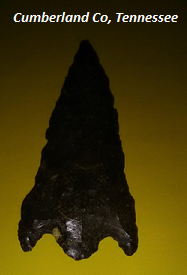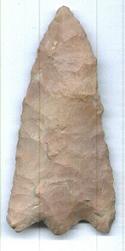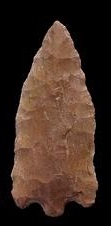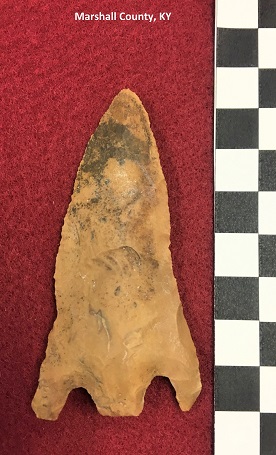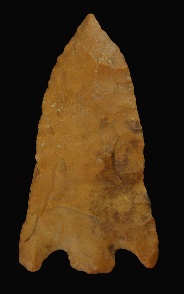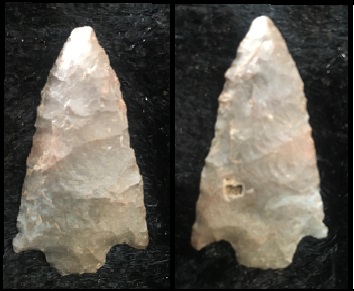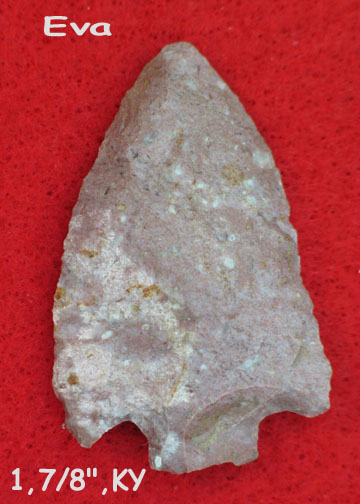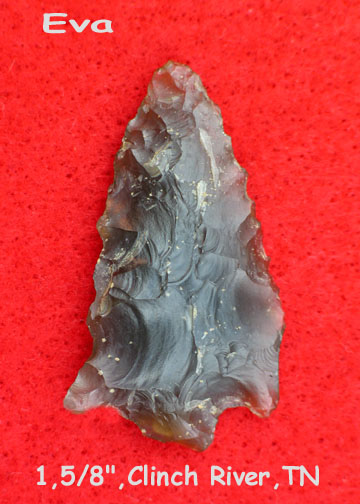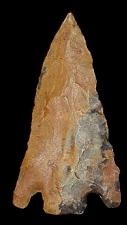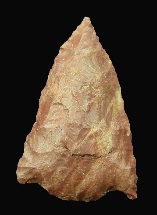Outline is Representative of Size and Shape:
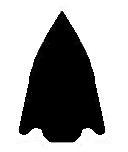
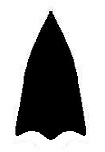
Type 2

Type 1
Name Details:
Identified By: T.M.N Lewis and Madeline Kneberg
Named For: Type Site
Date Identified: 1955
Type Site: Eva Site, Benton County, Tennessee
Identified By: T.M.N Lewis and Madeline Kneberg
Named For: Type Site
Date Identified: 1955
Type Site: Eva Site, Benton County, Tennessee
Point Validity:
Valid type
Kneberg was a prominent anthropologist and professor at the University of Tennessee. She is most recognized for her excavations through-out the Tennessee River Valley. This type was named in a professional publication and has many professional references. This is considered a valid type.
Kneberg was a prominent anthropologist and professor at the University of Tennessee. She is most recognized for her excavations through-out the Tennessee River Valley. This type was named in a professional publication and has many professional references. This is considered a valid type.
Eva Barbed
Type 1 and 2Cluster: Eva Cluster
Description of Physical Characteristics and Flaking Pattern:
This is a broad medium to large triangular points with a flattened to thin elliptical cross section. The blade is most commonly excurvate, but may also be inward recurvate. The shoulders are barbed due to the basal notch, but may diminish with each re-sharpening of the point. Two notches enter the base forming a stem that is straight to contracting and may be longer than the barbs. The base may range from straight to slightly convex and may have basal grinding and / or thinning. This point is manufactured using broad percussion flaking and finished with fine, well executed percussion flaking forming a random flaking pattern. Occasionally, fine pressure flaking is used for re-touching the blade.
Size Measurements:
Total Length - 48 to 96 mm (61 mm average), Stem Length - 5 to 7 mm (6 mm average), Blade Width - 25 to 39 mm (33 mm average), Stem Width - 11 to 36 mm (18 mm average), Thickness - 8 to 10 mm
Total Length - 48 to 96 mm (61 mm average), Stem Length - 5 to 7 mm (6 mm average), Blade Width - 25 to 39 mm (33 mm average), Stem Width - 11 to 36 mm (18 mm average), Thickness - 8 to 10 mm
Commonly Utilized Material:
Additional Comments:
Eva Type I (Early form) noted for shorter contracting stem. Eva Type I points are generally larger than the Type II points (Justice, 1987).
Eva Type II (Newer Form) noted for longer barbs and straight to rounded stem.
Lewis and Lewis (1961) studied the Morrisroe Site, Livingston County, Kentucky and identified four variants of the Eva point. The first two they listed as Eva Type I and Eve Type II, the other two they named Cypress Creek Type I and Cypress Creek Type II. However, the never described the Cypress Creek Type II (Nance, 1986).
Eva Type I (Early form) noted for shorter contracting stem. Eva Type I points are generally larger than the Type II points (Justice, 1987).
Eva Type II (Newer Form) noted for longer barbs and straight to rounded stem.
Lewis and Lewis (1961) studied the Morrisroe Site, Livingston County, Kentucky and identified four variants of the Eva point. The first two they listed as Eva Type I and Eve Type II, the other two they named Cypress Creek Type I and Cypress Creek Type II. However, the never described the Cypress Creek Type II (Nance, 1986).
Distribution: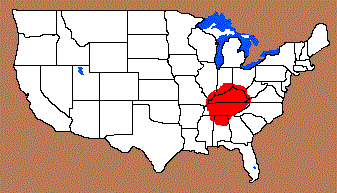
Distribution Comments:
This point is most commonly found in the western half of Tennessee in the Tennessee River valley. Frequency decreased in the remaining portion of the Tennessee River valley. It's occurrence rarely extends into the mid to upper Ohio River valley and into western Virginia, North Carolina, South Carolina, and Georgia.
This point is most commonly found in the western half of Tennessee in the Tennessee River valley. Frequency decreased in the remaining portion of the Tennessee River valley. It's occurrence rarely extends into the mid to upper Ohio River valley and into western Virginia, North Carolina, South Carolina, and Georgia.
Age / Periods:
Date: 7,500 - 6,000 B.P.
Cultural Period: Early Archaic
Glacial Period: Early Holocene
Culture:
Date: 7,500 - 6,000 B.P.
Cultural Period: Early Archaic
Glacial Period: Early Holocene
Culture:
Age Details:
Similar Points:
Citrus, Clay, Culbreath, Hamilton Stemmed, Hernando, Mehlville, Ouachita, Rankin, Smith, Wade
Citrus, Clay, Culbreath, Hamilton Stemmed, Hernando, Mehlville, Ouachita, Rankin, Smith, Wade


